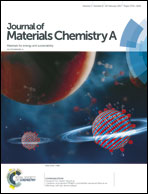Polyoxometalate modified pine cone biochar carbon for supercapacitor electrodes†
Abstract
Pine cones were used as a biomass template for the synthesis of activated carbons with high specific surface area (up to 2450 m2 g−1) and a pore structure optimized for the adsorption of redox active polyoxometalate (POM) clusters. We have found that POM adsorption is highly favored within a carbon matrix possessing pore diameters in the 1–2 nm range. These large micropores are big enough to accommodate the large POM cluster, while still being small enough to effectively trap and hold the molecule. Pine cone activated carbon with this optimal pore arrangement demonstrated ultra-high loading of the PMo12O403− (PMo12) molecule resulting in carbon–POM hybrid materials consisting of over 55 wt% PMo12. This large POM loading imparted tremendous redox activity to the already large double layer capacity of the carbon substrate, leading to a high areal capacitance of 1.19 F cm−2 for the hybrid material, close to 2.5 times larger than for unmodified carbon. We have also demonstrated that a mixed molecular modifier combining multiple POM chemistries can be adsorbed onto the activated carbon substrate to create a more ideally capacitive charge storage profile. These results demonstrate a promising method for the design of high performance yet cost effective hybrid energy storage electrodes.



 Please wait while we load your content...
Please wait while we load your content...